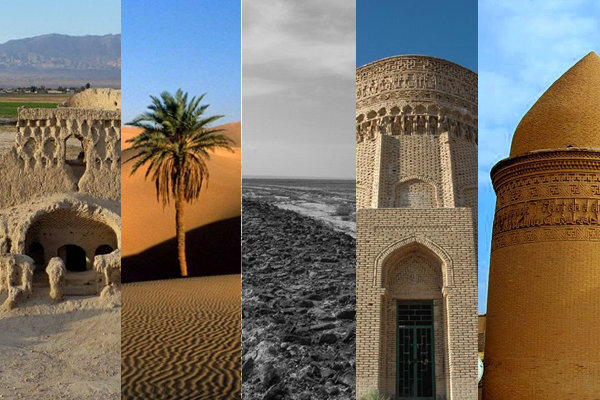Damghan, a treasure trove for cultural travelers and history enthusiasts

TEHRAN - Steeped in history and dotted with architectural marvels, Damghan in Iran’s Semnan province is a treasure trove for cultural travelers and history enthusiasts.
The ancient city, situated about 350 kilometers east of Tehran, is not only famed for its high-quality pistachios – often dubbed “the smiling nuts” – but also for its impressive collection of historical monuments, caravanserais, fortifications, and places of worship that echo the grandeur of bygone eras.
A city of mystics and legends
Legend has it that Damghan’s name is rooted in the ancient Persian word ‘Moghan’, referring to practitioners of mystical arts such as astrology, alchemy, and other esoteric sciences. Originally known as ‘Dah Moghan’, meaning "ten magi," the name gradually evolved into its present form, Damghan.
Throughout its rich history, Damghan has been a key city along the Silk Roads, serving as a significant trading hub connecting Merv to the Mediterranean coast, as documented in the International Dictionary of Historic Places. The city also provided a gateway to the Parthian capital of Hecatompylos, which rose to prominence following the Parthian conquest of the region after the fall of Alexander the Great.
Key attractions
Tarikhaneh, famed as Iran’s oldest standing mosque
Among Damghan’s most distinguished monuments is the Tarikhaneh Mosque, believed to be the oldest mosque in Iran still in its original form, dating back to the first century after the advent of Islam. Located in the southeastern part of the city, this mosque, alongside the historic mosque of Na’in in Isfahan province, stands as a rare example of pre-Seljuk Islamic architecture.
Constructed with Sassanid-era building techniques, the mosque bears remarkable resemblance to structures like Sarvestan Palace near Shiraz and the Palace of Ardeshir in Firuzabad. Some historians suggest that the mosque may have originally been a Zoroastrian fire temple.
The mosque features a spacious courtyard, flanked by porticos on three sides, and a gallery of 18 columns facing the Qibla (direction of prayer). Its Seljuk-era minaret, crowned with what is considered the oldest known tile inscription in Islamic architecture, further enhances its historical significance. The name Tarikhaneh, a fusion of the ancient Turkic term for “sky” or “god” (Tari, Tengri) and the Persian word for “house” (Khaneh), can be translated as “House of God.”
Tepe Hessar: an archaeological treasure trove
Located just outside the city, Tepe Hessar is an archaeological site of immense historical importance. Excavated in the 1930s by Prof. Ernst Herzfeld and later Dr. Erich Schmidt, the site reveals multiple layers of civilization, spanning from the 5th millennium BC to the Parthian and Seleucid periods.
Artifacts unearthed from Tepe Hessar, some dating back over 7,000 years, offer a window into the region's ancient past, with evidence of settlements from the Medes, Achaemenids, and later dynasties.
Ancint city walls and fortifications
Remnants of Damghan’s ancient fortifications still survive, with massive walls and battlements once wide enough to accommodate chariots, as described in historical accounts. Visitors can witness the enduring legacy of these defensive structures in the northern and southern outskirts of the city.
Seljuk-era architectural jewels
The Seljuk era enriched Damghan with several remarkable architectural works. Notable sites include the Shrine of Pir Alamdar, the Jame’ Mosque (Congregational Mosque) and its iconic minaret, Mansurkuh village, the Tower of Jafar’s Tomb, and the impressive Chehel-Dokhtaran Vault. The Seljuks introduced intricate brickwork decorations, breaking the monotony of early Islamic architecture and leaving behind masterpieces of artistic craftsmanship.
Chehel-Dokhtaran Vault: an enduring family mausoleum
Located in central Damghan, behind Jafar’s Tomb, the Chehel-Dokhtaran Vault (translated as "Vault of Forty Girls") was built in 1087, according to its Kufic inscription. Remarkably, despite Damghan’s location on an earthquake fault line, the mausoleum has withstood the test of time without significant structural damage.
The vault, with its onion-shaped dome, features exquisite brickwork and inscriptions, reflecting the artistry of the Seljuk period. Standing 14.8 meters tall, the structure was used as a family mausoleum, where inscriptions invoke divine mercy for the deceased.
Cheshmeh-Ali: a picturesque oasis
About 30 kilometers north of Damghan, Cheshmeh-Ali is a lush and scenic spring that has been a favored retreat since ancient times. During the Qajar era, this idyllic setting inspired the construction of several palatial structures, including those built by Fath-Ali Shah and Aqa Mohammad Khan. Fath-Ali Shah’s palace, uniquely situated in the center of the lagoon between two springs, continues to attract visitors seeking tranquility and history.
Ismaili fortresses: echoes of a mysterious past
To the north of Damghan, two Ismaili fortresses perch atop rugged mountains, once serving as strongholds for the esoteric Ismaili sect during the medieval period. The Gerdkuh Fortress, located about 5 kilometers from the city, and Mehrnegar Fortress, on Mansurkuh Mountain (22 kilometers north of Damghan), offer breathtaking views and a glimpse into the strategic prowess of the Ismailis.
AM
